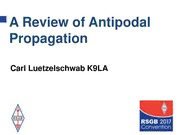
A Review of Antipodal Propagation - K9LA RSGB Convention 2017 PDF
Preview A Review of Antipodal Propagation - K9LA RSGB Convention 2017
A Review of Antipodal Propagation Carl Luetzelschwab K9LA What’s an Antipode? It’s the QTH on the opposite side of the Earth from you Extend a line from your QTH thru the center of the Earth to the other side of the Earth Where it comes out on the other side of the Earth is your antipode To calculate your antipode Reverse the sign of your latitude Add 180o to your longitude What’s the Antipode of Milton Keynes? About 500 km southeast of New Zealand You’d end up getting wet (which would be okay as you would get kind of hot going thru the Earth) Why This Topic? An e-mail from Roger G3SXW and Steve PJ4DX Roger’s question was “how far away from the antipode does signal enhancement occur?” G3SXW and G3TXF were at ZL7 in Sept 2001 All great circle paths out of ZL7 meet at the ZL7 antipode in southern France Roger felt there was a distinct enhancement of U.K. signals (the U.K. is ~500 miles NNW of the antipode) References (1) “An estimate of the size of the antipodal area in short-wave radio propagation”, Whale, JATP, Vol 9 No 2-3, August/September 1956 (2) “An Experimental Investigation of Signal Strength in the Area Around a Transmitter’s Antipode”, Pipp and Webster, Radio Science, Vol 68D No 3, March 1964 (3) “Measurements of Antipodal High-Frequency Radio Signals”, Banks, JGR, Vol 70 No 3, February 1965 (4) Ionospheric Radio Propagation, Davies, 1965 (5) “Radio-Wave Propagation to the Antipode”, Gerson, et al, Syracuse University Research Corp, February 1969 References continued (6) “Power distribution near the antipode of a short-wave transmitter”, Bold, JATP, Vol 31, April 1969 (7) “The Influence of Chordal Paths on Signals Propagating to the near Antipode of an HF Radio Transmitter”, Bold, IEEE Trans A&P, AP-20 No 6, November 1972 (8) “On the propagation of short waves over very long distances: predictions and observations”, Hortenbach and Rogler, Telecommunication Journal, Vol 46, June 1979 (9) Ionospheric Radio, Davies, 1990 (10) “Antipodal Propagation of Decameter Radio Waves”, Bryantsev, Radiophysics and Quantum Electronics, Vol 55 No 9, February 2013 (thanks NQ6Z for finding this one) There are more, but these were sufficient to put together this presentation Topics I’ll look at the following Duration of openings Amount of enhancement (focusing gain) Area of enhancement I’ll also discuss the contributions of chordal hops to antipodal propagation Duration of Openings Duration of Openings Reference 3 (Measurements of Antipodal High- Frequency Radio Signals) Transmitter in Texas, Receiver on ship in Indian Ocean at antipode Many frequencies (data at 12, 14, 18 and 22 MHz) October 1962, R = 31 12 Many hours of openings Duration of Openings Reference 5 (Radio-Wave Propagation to the Antipode) Transmitter in Perth, Receiver in Bermuda (80 km from antipode) 5.05 MHz, 15.905 MHz and 30.005 MHz 1960 and 1961, R from 129 in 1/60 to 49 in 12/61 12 Many months of openings
